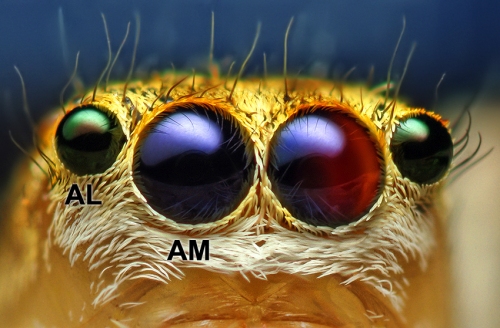The rather amusing cover of this month’s JEB caught my eye; I am always excited to find out about the outlandish and creative methods that scientists dream up in order to test their ideas.
Yep, that’s a jumping spider holding a styrofoam ball, tethered to the ceiling. So what the heck could possibly be going on here?
The cover shot belongs to this paper. The researchers wanted to get a better handle on the contributions of specific jumping spider eye sets to the animal’s overall visual perception and behavior. Like many arachnids, jumping spiders have eight corneal eyes. Two sets of these eyes are forward facing; the anterior median (AM) and anterior lateral (AL) eyes (see image below). The large set of AM eyes are extremely acute, boasting the highest known resolution among the arthropods. However, they have an extremely narrow field of view since their retina is organized into a thin strip, not unlike the ribbon retina of larval diving beetles. The AL eyes, on the other hand, have a much larger, overlapping field of view and are very good at detecting movement. When the spider detects something with the AL eyes, it reorients its body to bring the high-resolution AM eyes to bear on the target. When jumping spiders are active they can be seen constantly preforming these reorienting body movements, endowing them with a great deal of inquisitive charm and personality (adorable videos).

Anterior median (AM) and anterior lateral (AL) eyes of Maevia inclemens. Photo: Thomas Shahan
Now, back to the recently published study. The researchers wanted to assess the importance of the AL eyes in the orientation response of jumping spiders. They used an opaque silicone paint to block out all the animal’s eyes besides the two AL eyes. They then tethered the jumping spiders from above using a piece of cork and beeswax. Finally they ‘handed’ the spiders a gridded polystyrene sphere (which they readily accepted), and positioned them in front of computer LCD monitors. Varying dot stimuli were displayed on the monitors, and the orientation response of the spiders to these stimuli were easily recorded by observing the underfoot movements of the polystyrene sphere.
The researchers found that the jumping spider’s AL eyes are crucial to orientation responses, and therefore extremely important to the spider’s visual ecology. In fact, the spiders in this study demonstrated complete hunting behaviors using only the AL eyes. In addition, the researchers noted that increased hunger yielded stronger predatory response in the jumping spiders. Finally, they observed that overall, females showed a greater orientation response to stimuli than males. The researchers suggest that this is due to visual dimorphism, possibly related to the female’s need to carefully scrutinize the courting displays preformed by males.
So, that’s why the cover of JEB is a photo of a hanging jumping spider holding a polystyrene ball. However, the best part of this outlandish-seeming experiment is that the tests were non-destructive. The paint covering the eyes, and the tether attached to the back, could be removed without harming the jumping spiders. They were, unfortunately, eventually forced to give up their toy ball.
_
References:
- Zurek, D., Taylor, A., Evans, C., & Nelson, X. (2010). The role of the anterior lateral eyes in the vision-based behaviour of jumping spiders. Journal of Experimental Biology, 213 (14), 2372-2378 DOI: 10.1242/jeb.042382
- Go look at more of Thomas Shahan’s unbelievable photography, here.

















It must be the palps. Yes, the palps and the giant AM eyes that make jumping spiders freaking irresistible. I can’t help it, they just make me break down into an overwhelming surge of OMG SO CUUUUTE whenever I look at them…
Nice blog, btw! Might keep me busy for the night… (marine spiders and mantis shrimps = awesome!)
Cheers!
-Psi-
I think the way they move is the primary reason jumping spiders have so much personality. Attentive, dramatic, inquisitiveness can go a long way for an animal. If a jumping spider just stood still, coldly observing the world like a huntsman, they would lose a lot of their adorableness.
Things like this are the reason why I study biology…awesome and cute creatures like jumping spiders and creative yet a bit freaky experiments!
Love your blog by the way, great work!
Fabulous entry. Thanks for referring us back to the gobsmackingly cute videos. Cute is nice, but the third one helped me identify a mystery spider I’ve been wondering about for over a year.
Also, I appreciate the note that the spiders weren’t harmed by the paint and tethering. 🙂
I’ll right away clutch your rss as I can’t find your email
subscription link or newsletter service. Do you’ve any?
Please allow me recognize so that I may subscribe. Thanks.
That is really attention-grabbing, You’re a very professional blogger. I’ve joined your feed and look forward
to looking for extra of your great post. Also, I have shared your website in
my social networks
If you have money then there is lot of excellent treatments are available for you,
which you can get. Once you have a working list of three
or four eye doctors who are located near you,
pick up the phone and call the office. This mixture can be stored in a glass jar
in the refrigerator for three or four days.
If you have money then there is lot of excellent treatments are available
for you, which you can get. They can also prescribe glasses and contacts to
their patients. The surgery or treatment must be taken from a well qualified surgeon or
an eye doctor.
Excellent way of telling, and good post to obtain information on the topic of my presentation focus,
which i am going to present in academy.